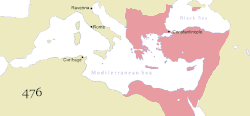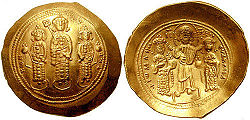Byzantine Empire under the Doukas dynasty
Byzantine Empire
| ||
|---|---|---|
• 1059–1067 | Constantine X Doukas | |
• 1071–1078 | Michael VII Doukas | |
| History | ||
• Abdication of Isaac I Komnenos | 1059 | |
• Coronation of Alexios I | 1081 | |
| History of the Byzantine Empire |
|---|
 |
| Preceding |
|
| Early period (330–717) |
|
| Middle period (717–1204) |
| Late period (1204–1453) |
| Timeline |
| By topic |
|
|

The
Under the rule of the Doukids, Byzantium was fighting a
Although the Crusades gave the empire a temporary respite during the 12th century, it never recovered fully and eventually entered its period of fragmentation and terminal decline under the pressure of the Ottomans in the late medieval period.
In 1077,
Constantine X
The Doukai of the 11th century provided several generals, governors. They seem to have come from Paphlagonia, and were exceedingly wealthy, possessing extensive estates in Anatolia. The relationship of this group with the Doukai of the 9th and 10th centuries is unclear; the contemporary writers Michael Psellos and Nicholas Kallikles affirm such a relationship, but Zonaras openly questioned it.[1][4] [2][5] Before becoming emperor, Constantine X had married into the powerful
Constantine Doukas gained influence after he married, as his second wife,
The new emperor quickly associated two of his young sons in power,
Constantine lost most of
Already old and unhealthy when he came to power, Constantine died on May 22, 1067. His final act was to demand that only his sons succeed him, forcing his wife Eudokia Makrembolitissa to take a vow not to remarry.[15]
Romanos Diogenes

Romanos Diogenes was convicted of attempting to usurp the throne of the sons of
The first military operations of Romanos took place in 1068 and did achieve a measure of success, although the Byzantine province of Syria came under threat by the
In 1070, Romanos was detained in Constantinople by administrative issues, and was unable to go on campaign himself. General
Even while Romanos negotiated with Alp Arslan over the return of Manzikert, he marched at the head of a large army with the intent of recovering the fortress.[22] This led to the fateful Battle of Manzikert of 26 August 1071. Romanos decided to divide his army, dispatching a part to attack Akhlat, while continuing to advance on Manzikert with the main body of the army. He did manage to recapture Manzikert, but became aware of the Seljuk army rapidly approaching. Romanos ordered the forces attacking Akhlat to rejoin him, but these unexpectedly came across another large Turkish army, forcing them to retreat back into Mesopotamia.[23]
Facing a superior force, Romanos was further weakened by his Uzes mercenaries deserting to the enemy.[24] Arslan proposed a peace treaty with favourable terms for Romanos, but the emperor declined, hoping for a decisive military victory.[25] The battle lasted all day without either side gaining any decisive advantage, but as the emperor ordered a part of his centre to return to camp, the order was misunderstood and confusion ensued, which was taken advantage of by Andronikos Doukas, who commanded the reserves, and was the son of Caesar John Doukas, to betray Romanos. Claiming that the emperor was dead, Andronikos marched away from the battle with some 30,000 men who were supposed to cover the army's retreat.[26]
When Romanos became aware of what had happened, he tried to recover the situation by making a defiant stand, fighting valiantly even after his horse had been killed under him, but he was wounded in the hand, which prevented him from wielding a sword, and was soon taken prisoner.[27] Arslan released the emperor against the substantial ransom of 1,500,000 nomismata, with a further 360,000 nomismata to be paid annually.[28]
In the meantime, the opposition faction scheming against Romanos IV decided to exploit the situation. The Caesar John Doukas and Michael Psellos forced Eudokia to retire to a monastery, and they prevailed upon Michael VII to declare Romanos IV deposed.[29] They then refused to honor the agreement made between Arslan and the former emperor. As Romanos returned from captivity, he fought a battle against the Doukas family at Dokeia, but was defeated.[30] He retreated to the fortress of Tyropoion, and from there to Adana in Cilicia. Pursued by Andronikos, he was eventually forced to surrender by the garrison at Adana upon receiving assurances of his personal safety.[31] John Doukas reneged on the agreement and sent men to have Romanos cruelly blinded on June 29, 1072, before sending him into exile to Prote in the Sea of Marmara. Without medical assistance, his wound became infected, and he soon endured a painfully lingering death.[citation needed]
Michael VII

When Romanos IV was defeated and captured, Michael VII remained in the background, while the initiative was taken by his uncle
Although still advised by Michael Psellos and John Doukas, Michael VII became increasingly reliant on his finance minister


After Manzikert, the Byzantine government sent a new army to contain the
These misfortunes caused widespread dissatisfaction, exacerbated by the devaluation of the currency, which gave the emperor his nickname Parapinakēs, "minus a quarter".[citation needed]
Nikephoros III
In 1078 two generals,
Nikephoros Botaneiates marched upon Nicaea, where he proclaimed himself emperor. In the face of the threat posed by Nikephoros Bryennios, his election was ratified by the aristocracy and clergy, while Michael VII resigned the throne with hardly a struggle on 31 March 1078 and retired into the Monastery of Stoudios.[35][a]
On 24 March 1078,
Alexios was ordered to march against his brother-in-law
Isaac and Alexios left Constantinople in mid-February 1081 to raise an army against Botaneiates.[42] After bribing the Western troops guarding the city, Isaac and Alexios Komnenos entered the capital victoriously on 1 April 1081.[43] Alexios was crowned emperor, establishing the Komnenos dynasty.
See also
- Doukas Dynasty and related family tree
- Family trees of the Byzantine imperial dynasties
- Byzantine–Seljuq wars
- Uprising of Georgi Voiteh
- Decline of the Byzantine Empire
- Byzantine Empire under the Justinian dynasty
- Byzantine Empire under the Heraclian dynasty
- Byzantine Empire under the Isaurian dynasty
- Byzantine Empire under the Macedonian dynasty
- Byzantine Empire under the Angelos dynasty
- Byzantine Empire under the Palaiologos dynasty
Notes
- metropolitan of Ephesus[citation needed] and died in Constantinople in c. 1090.[36]
- ^ a b Kazhdan 1991, p. 655.
- ^ a b Krsmanović 2003, Chapter 5.1.
- ^ Krsmanović 2003, Chapter 5.4.
- ^ Polemis 1968, pp. 2, 16.
- ^ Polemis 1968, pp. 8–11.
- ^ Krsmanović 2003, Chapter 5.2.
- ^ a b c Kazhdan 1991, p. 504.
- ^ Norwich 1993, p. 337.
- ^ Finlay 1854, p. 15.
- ^ Norwich 1993, p. 341.
- ^ Finlay 1854, p. 17.
- ^ Norwich 1993, p. 342.
- ^ Finlay 1854, p. 27.
- ^ Finlay 1854, p. 24.
- ^ Norwich 1993, p. 343.
- ^ Soloviev 1935, pp. 156–158.
- ^ Norwich 1993, p. 344.
- ^ Dumbarton Oaks 1973, p. 785.
- ^ Finlay 1854, p. 33.
- ^ Finlay 1854, p. 35.
- ^ Finlay 1854, p. 36.
- ^ Norwich 1993, p. 346.
- ^ Norwich 1993, p. 348.
- ^ Norwich 1993, p. 349.
- ^ Norwich 1993, p. 351.
- ^ Norwich 1993, p. 352.
- ^ Norwich 1993, p. 353.
- ^ Finlay 1854, p. 42.
- ^ a b c Norwich 1993, p. 355.
- ^ Polemis 1968, p. 59.
- ^ Norwich 1993, p. 356.
- ^ a b c Norwich 1993, p. 359.
- ^ a b Finlay 1854, p. 52.
- ^ a b Norwich 1993, p. 360.
- ^ a b Norwich 1993, p. 361.
- ^ Kazhdan 1991, p. 1366.
- ^ Norwich 1996, p. 3.
- ^ a b Finlay 1854, p. 60.
- ^ Garland 2007.
- ^ Norwich 1995, p. 5.
- ^ "Alexiad" 2,1,4–6, 2.3.2–3,2.3.4;[full citation needed] cf, Bryennius 4.2, who dates the adoption to early in the reign of Botaneiates.[full citation needed]
- ^ Norwich 1995, p. 6.
- ^ Finlay 1854, p. 63.
References
- Dumbarton Oaks (1973), Catalogue of the Byzantine Coins in the Dumbarton Oaks Collection and in the Whittemore Collection: Leo III to Nicephorus III, 717–1081
- Finlay, George (1854), History of the Byzantine and Greek Empires from 1057–1453, vol. 2, William Blackwood & Sons
- Garland, Lynda (25 May 2007), Anna Dalassena, Mother of Alexius I Comnenus (1081-1118), De Imperatoribus Romanis (An Online Encyclopedia of Roman Rulers)
- ISBN 0-19-504652-8.
- Krsmanović, Bojana (11 September 2003), "Doukas family", Encyclopaedia of the Hellenic World, Asia Minor, Athens, Greece: Foundation of the Hellenic World, archived from the original on 21 July 2011, retrieved 17 April 2012
- Norwich, John Julius (1993), Byzantium: The Apogee, Penguin, ISBN 0-14-011448-3
- Norwich, John J. (1995), Byzantium: The Decline and Fall, Alfred A. Knopf, Inc., ISBN 978-0-679-41650-0
- Norwich, John Julius (1996), Byzantium: The Decline and Fall, Penguin, ISBN 0-14-011449-1
- Polemis, Demetrios I. (1968). The Doukai: A Contribution to Byzantine Prosopography. London: The Athlone Press. OCLC 299868377.
- Soloviev, A.V. (1935), "Les emblèmes héraldiques de Byzance et les Slaves", Seminarium Kondakovianum (in French), 7
Further reading
- Cheynet, Jean-Claude (1996), Pouvoir et Contestations à Byzance (963–1210) (in French), Paris: Publications de la Sorbonne, ISBN 978-2-85944-168-5
